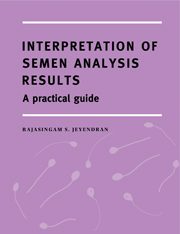Book contents
- Frontmatter
- Contents
- Preface
- Introduction
- Hypotheses on fertile ejaculate identification
- Male reproductive system background
- Semen analysis interpretation
- ROUTINE SEMEN ANALYSIS
- SPECIALIZED SEMEN ANALYSIS
- The logical sequence of routine and specialized semen analysis
- Semen component point-of-origin
- Conclusion
- Standard semen variable reference values for clinical interpretation and diagnosis (Table 1)
- Specialized semen test reference values for clinical interpretation and diagnosis (Table 2)
- Spermatozoa biochemical analysis and seminal plasma chemical analysis reference values for clinical interpretation and diagnosis (Table 3)
- Glossary
- Suggested additional reading
- Index
Conclusion
Published online by Cambridge University Press: 05 August 2016
- Frontmatter
- Contents
- Preface
- Introduction
- Hypotheses on fertile ejaculate identification
- Male reproductive system background
- Semen analysis interpretation
- ROUTINE SEMEN ANALYSIS
- SPECIALIZED SEMEN ANALYSIS
- The logical sequence of routine and specialized semen analysis
- Semen component point-of-origin
- Conclusion
- Standard semen variable reference values for clinical interpretation and diagnosis (Table 1)
- Specialized semen test reference values for clinical interpretation and diagnosis (Table 2)
- Spermatozoa biochemical analysis and seminal plasma chemical analysis reference values for clinical interpretation and diagnosis (Table 3)
- Glossary
- Suggested additional reading
- Index
Summary
A major problem in semen analysis interpretation has been equating ‘abnormal’ with Infertile’ or ‘subfertile’ results. A semen variable abnormality simply means that it deviates from the average (normal) range. For example, consider the WHO Laboratory Manual(1999) standard reference values. Such a deviation may, or may not, cause infertility, depending on magnitude of severity and the fertility status of the spouse. A fertility problem does not exist simply because a semen variable is in an abnormal range, exemplified when overall semen quality can vary markedly between two consecutive ejaculates from the same individual. Also, some abnormalities have a greater effect on fertility than others. To avoid such confusion, we have now added a ‘grey’ (suspect) range of values to each variable and suggest terms such as ‘usual,’ ‘equivocal,’ and ‘unusual’ (see Table 1-3). Even so, abnormal and even unusual does not mean infertile, so that an abnormal (unusual) ejaculate differs from a normal (usual) ejaculate only in that it has less likelihood of being infertile (unless the other characteristics are extremely poor). Unfortunately, the relative fertility potential is often of little interest to a clinician who wants to know whether the patient has an overall fertility problem or not.
Since the term ‘abnormal’ is rather meaningless from a fertility standpoint, cutoff should be determined for each semen indicator (reference value) below a 95% infertility certainty. More information is required to establish firmly such ‘infertility’ values for these indicators. When one or more indicator falls into this infertility category, the ejaculate is almost certainly infertile. If no indicator falls into this category, a definitive diagnosis cannot be reached. Whenever indicators fall into the questionable, borderline category, such a phrase as less likely to be fertile’ is applicable.
In every section, discussions and recommendations have been made regarding particular sperm parameters and their likely diagnosis. A vital element of such analyses involves consideration of the female. For example, sperm capacitation and acrosome reaction is as much dependent upon the female reproductive tract as inherent sperm quality. Consequently, sperm diagnosis might be qualified as ‘normal,’ yet the couple still may not conceive, due to ignorance of female reproductive tract problems or incompatibilities. Such a scenario can be confirmed when either the couple successfully conceives through IVF, or if the male, after changing partners, is able to impregnate his new spouse.
- Type
- Chapter
- Information
- Interpretation of Semen Analysis ResultsA Practical Guide, pp. 81 - 82Publisher: Cambridge University PressPrint publication year: 2000



